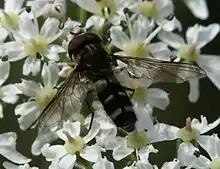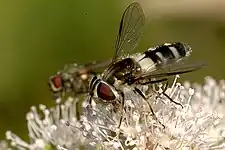Leucozona laternaria
Leucozona laternaria is a European species of hoverfly.[1][2][3][4]
| Leucozona laternaria | |
|---|---|
 | |
| Male | |
 | |
| Female | |
| Scientific classification | |
| Domain: | Eukaryota |
| Kingdom: | Animalia |
| Phylum: | Arthropoda |
| Class: | Insecta |
| Order: | Diptera |
| Family: | Syrphidae |
| Genus: | Leucozona |
| Subgenus: | Ischyrosyrphus |
| Species: | L. laternaria |
| Binomial name | |
| Leucozona laternaria (Müller, 1776) | |
| Synonyms | |
| |
Description
For terms see Morphology of Diptera
Wing length 7 to 10 mm (0.28 to 0.39 in). Scutellum black. Tergite 2 has large well separated silverish-white to yellowish- white marks (often merged).Tergites 3 and 4 have narrow or absent markings. The male terminalia are figured by Hippa (1968).[5]
See references for determination.[6]
[7]
[8][9]
Distribution
Palearctic from Fennoscandia South to the Pyrenees. Ireland East through North and Central Europe into Turkey and European Russia, then Russian Far East and Siberia and the Pacific coast (Kuril Islands and Japan). [10][11]
Biology
Habitat: Deciduous forest and wetland, along forest streams with Salix and Alnus scrub, fen carr.[12] Flowers visited include white umbellifers, Cirsium arvense, Convolvulus, Filipendula ulmaria.[13] The Flight period is June to August. The larvae feed on aphids on ground flora.
References
- Ball, S.G.; Morris, R.K.A. (2000). Provisional atlas of British hoverflies (Diptera, Syrphidae). Monks Wood, UK: Biological Record Centre. pp. 167 pages. ISBN 1-870393-54-6.
- Morris, Roger K. A. (1999). Hoverflies of Surrey. Surrey Wildlife Trust. p. 244. ISBN 0-9526065-3-4.
- Stubbs, Alan E.; Falk, Steven J. (1983). British Hoverflies: An Illustrated Identification Guide. British Entomological & Natural History Society. p. 253, xvpp.
- Van Veen, M.P. (2004). Hoverflies of Northwest Europe, Identification Keys to the Syrphidae (Hardback). Utrecht: KNNV Publishing. p. 254. ISBN 90-5011-199-8.
- Hippa, H. (1968) A generic revision of the genus Syrphus and allied genera (Diptera: Syrphidae) in the Palearctic region, with descriptions of the male genitalia. Acta Ent.Fenn., 25: 1-94.
- Van Veen, M. (2004) Hoverflies of Northwest Europe: identification keys to the Syrphidae. 256pp. KNNV Publishing, Utrecht.addendum
- Van der Goot,V.S. (1981) De zweefvliegen van Noordwest - Europa en Europees Rusland, in het bijzonder van de Benelux. KNNV, Uitgave no.32: 275pp. Amsterdam.
- Bei-Bienko, G.Y. & Steyskal, G.C. (1988) Keys to the Insects of the European Part of the USSR, Volume V: Diptera and Siphonaptera, Part I. Amerind Publishing Co., New Delhi. ISBN 81-205-0080-6.
- Coe, R.L. (1953) Diptera: Syrphidae. Handbks.ident.Br.insects, 10(1): 1-98. R.ent.Soc.London. pdf
- Fauna Europaea
- Peck, L.V. (1988) Syrphidae. In: Soos, A. & Papp, L. (eds.) Catalogue of Palaearctic Diptera, 8: 11-230. Akad.Kiado, Budapest.
- Speight, M.C.D. (2011). "Species accounts of European Syrphidae (Diptera)" (PDF). Syrph the Net, the database of European Syrphidae. 65: 285pp.
- de Buck, N. (1990) Bloembezoek en bestuivingsecologie van Zweefvliegen (Diptera, Syrphidae) in het bijzonder voor België. Doc.Trav. IRSNB, no.60, 1-167.